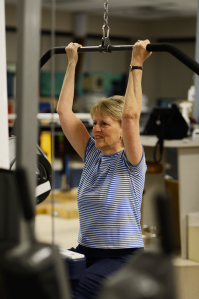
BEST for Bones — How women are fighting bone loss with physical therapy
By Shannon Whitney
This story is featured in the Summer 2013 edition of myBoone Health magazine. Click here for a free subscription.
Emily Frazier knew she was at risk for osteoporosis. Her mother began losing height in her 70’s, so it runs in the family. On top of that, Emily is a petite, Caucasian woman in her 60’s—a prime candidate for the feared bone disease that could slow down her busy life.
A registered nurse at Boone Hospital, Emily has always been an active mother and now a grandmother. When her DEXA scan showed that Emily had lost significant bone density and was in a pre-osteoporosis stage called osteopenia, she knew she had to make a change.
“I was slightly low. I don’t have osteoporosis. I’m getting toward that, but this is the time. If I’m ever going to improve, it’s now. I should have done it earlier,” explains Emily.
Following the BEST
Emily got a prescription from her physician to meet with a physical therapist at Boone Therapy to work on improving her bone strength. That’s when she was introduced to Laura Grise, a physical therapist who recently started working to combat osteoporosis by using the BEST Study.
BEST stands for Bone Estrogen Strength Training. The study conducted at the University of Arizona showed that weight-training exercises made a positive difference in the bone density of post-menopausal women.
“There’s some cardio, some postural exercises, but the main component is weightlifting,” said Laura. “Doing specific exercises that we know loads the bones, specifically the spine and the hips because they are the most at risk for fracture.”
Laura adapts the program to fit the needs of her Boone Therapy clients, including Emily. For the first 10 sessions or so, Laura taught Emily how to use the weight machines to do the exercises suggested by the study. Laura even does the exercises herself since osteoporosis runs in her family history as well.
“Since a lot of women have never lifted weights before, we work on proper technique, proper form with the weights and good posture,” said Laura of the training.
Since then, Emily has been working out three times a week at WELLAWARE.
She’s seven months into the program. After a year, she’ll have another DEXA scan to see if her bones look denser.
Feeling better
“The idea is to progress with your weight lifting by lifting heaver and heavier weights,” described Laura. “It stresses the bone, but you need to stress the bone, but not to the point it breaks. You need to stress the bone to build bone.”
In adding that stress every other day, Emily is feeling the difference.
“I don’t know what it’s done to my bones yet, but I am much stronger and much more fit. I have much more endurance,” exclaimed Emily. “I could walk a distance and not have any problems, but now I notice that it’s not even an effort. I’m a little firmer and lost a little weight too.”
On days between her weightlifting workouts, Emily walks to stay active. Laura suggests giving the bones at least 48 hours to recover after lifting.
Everyone loses some bone density as they age. Post-menopausal women are most susceptible to osteoporosis, but men can have it also. Building bone strength is crucial as the body ages and prevents any bone decay.
Good, strong bones
Using the BEST Study can combat bone density loss that leads to osteoporosis, and Emily and Laura want to share the good news. They are both enjoying the program so far and speak highly of it to women and men looking to do something about bone strength.
 “A lot of middle aged women think, ‘I’m getting older, my mom had osteoporosis and I’ll probably get it, and there’s nothing I can do about it,’” said Emily. “But that’s not true.”
“A lot of middle aged women think, ‘I’m getting older, my mom had osteoporosis and I’ll probably get it, and there’s nothing I can do about it,’” said Emily. “But that’s not true.”
“I think the most important thing for women to know is that there is something they can do to prevent osteoporosis and improve their quality of life,” said Laura. “There is something that you can do to take responsibility and charge of your own health.”
Dr. Barbara Tellerman is an advocate for bone health. She sees patients every day who suffer from fractures caused by osteoporosis. Boone Hospital Center offers services to help with the management of these patients from diagnosis, treatment of symptoms and disseminating information to prevent future fractures.
“Bone health is extremely important and it determines the quality of life and your longevity. You’re only as strong as your weakest link,” said Dr. Tellerman.
Another key to reversing bone loss is calcium. Emily occasionally takes supplements, but prefers to eat a calcium-rich diet, including her favorite — broccoli.
Both Emily and Laura are looking forward to seeing results in their upcoming DEXA scans. They both give Boone Hospital credit for making it easy to achieve their fitness goals.
“It’s a great environment, and it’s convenient. I’ve enjoyed it,” said Emily.